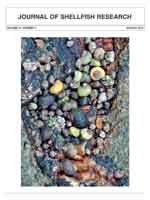A previous study revealed genetic differences among collections of the commercially exploited geoduck clam (Panopea generosa) in Puget Sound, WA, but this heterogeneity did not follow an isolation-by-distance model. In this study, we investigated whether these differences were ephemeral or stable and tested predictions of the sweepstakes recruitment hypothesis, in which individuals show a high variance in reproductive success. We genotyped 11 allozyme and 7 microsatellite loci in 2,021 geoducks from 2 sites in Puget Sound and aged individuals by counting annuli in thin-section chondrophores under light microscopy. Genotypic data were then collated by year-class to test predictions of the sweepstakes recruitment hypothesis with allele count rarefaction, year-class relatedness, and 3 estimators of efective population size (Ne) using temporal shifts in allele frequencies. Although estimates of Ne were similar among year-classes, spatial shifts in allele frequencies and year-class strengths were detected among stations at 1 site, indicating that patchy settlement may be the result of an interaction between larval behavior during dispersal and hydrology.
How to translate text using browser tools
1 August 2012
Temporal Genetic Similarity Among Year-Classes of the Pacific Geoduck Clam (Panopea generosa Gould 1850): A Species Exhibiting Spatial Genetic Patchiness
Brent Vadopalas,
Larry L. Leclair,
Paul Bentzen
ACCESS THE FULL ARTICLE

Journal of Shellfish Research
Vol. 31 • No. 3
August 2012
Vol. 31 • No. 3
August 2012
effective population size
geoduck
isolation by distance
Panopea generosa
sweepstakes recruitment




